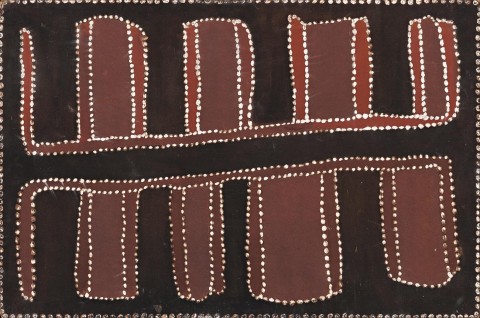KUNUNURRA BRIDGE, 1987
ROVER THOMAS (JOOLAMA)
natural earth pigments and natural binders on composition board
61.0 x 91.5 cm
bears inscription verso: Mary Macha cat. PT4687 and iRRRR
Commissioned by Mary Macha, Perth
Private collection, Perth
Private collection, Melbourne
Blue Chip X: The Collector’s Exhibition, Niagara Galleries, Melbourne, 4 March – 5 April 2008, cat. 18 (label attached verso)
Railway Bridge, Katherine, 1984, earth pigments and natural binder on composition board, 59.8 x 122.1 cm, in the collection of the National Gallery of Victoria, Melbourne, illus. in Ryan, J. and Akerman, K., Images of Power: Aboriginal Art of the Kimberley, National Gallery of Victoria, Melbourne, pp. 58 – 59
Rover Thomas functioned as an illustrator and storyteller and saw his paintings as landscapes, not static records but rather living portraits of land incorporating the physical, historical and metaphysical; the present and the past. His subject matter was not limited to his homeland and as Mary Macha remembered ‘He'd paint what he wanted to paint; his country, the East Kimberley, Perth, Katherine, Broome country, all over the place’.1 Similar to the artist's other depictions of man-made landmarks such as Kununurra Turnoff, 1986, Railway Bridge, Katherine, 1984, Kimberley Crossroads, 1990 or Swan River, 1991, Kununurra Bridge, 1987 is minimal in composition yet complex in meaning – here history, geography, mythology, knowledge and the lived experience that underpin much Aboriginal art are simultaneously represented. As curator Hetti Perkins has noted, ‘nowhere has the merging of the past and present, the spiritual and physical been more clearly realised than in Thomas's paintings’.2
Thomas used his deeply personal vision to redefine the pictorial conventions of the region and Kununurra Bridge, where an aerial planar view depicts the road bridge as flattened country, typifies the distinctive characteristics of his painting. However, in this image the curvilinear lines found in much of his work give way to a more angular composition, reflecting the man-made character of building and construction. Painted on the textured side of a sheet of Masonite with a black charcoal ground, the palette is derived from the deep brown and red ochre of the Kimberley landscape.
Rover Thomas began to paint in the early 1980s after working for more than thirty years as a stockman and labourer in his home country of the Great Sandy and Gibson Deserts. By the mid-1980s his work had been represented in many group exhibitions and he was increasingly recognised as an accomplished and distinguished artist. In 1990 Rover Thomas, together with Trevor Nickolls, represented Australia at the Venice Biennale, (the first two Indigenous artists selected to do so) and he has since been the subject of two important solo exhibitions, Roads Cross: The Paintings of Rover Thomas, National Gallery of Australia, Canberra in 1994 and I Want to Paint, a travelling exhibition touring nationally from 2003 to 2005.
1. Mary Macha and Don McLeod interviewed by Peppercorn, D., March 2003 in Rover Thomas; I Want to Paint, exhibition catalogue, Heytesbury Pty Ltd, Perth, 2003, p. 51
2. Perkins, H. Traditions Today; Indigenous Art in Australia, Art Gallery of New South Wales, Sydney, 2004, p. 134
CRISPIN GUTTERIDGE
Rover Thomas (Joolama) lived and worked in Warmun, Western Australia
language group: Kukatja/Wangkajunga
SELECTED COLLECTIONS
AAMU Museum of Contemporary Aboriginal Art, Utrecht, Netherlands
Art Gallery of New South Wales, Sydney
Art Gallery of South Australia, Adelaide
Art Gallery of Western Australia, Perth
Australian War Memorial, Canberra
Musée du Quai Branly, Paris, France
Museum and Art Gallery of the Northern Territory, Darwin
National Gallery of Australia, Canberra
National Gallery of Victoria, Melbourne
Parliament House Art Collection, Canberra
Queensland Art Gallery / Gallery of Modern Art, Brisbane
